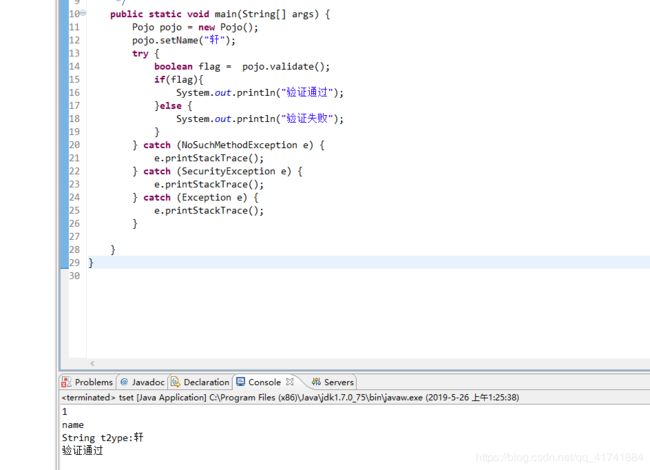Java自定义注解实现验证实体类属性的合法性
一、注解的基础
1.注解的定义:Java文件叫做Annotation,用@interface表示。
2.元注解:@interface上面按需要注解上一些东西,包括@Retention、@Target、@Document、@Inherited四种。
3.注解的保留策略:
@Retention(RetentionPolicy.SOURCE) // 注解仅存在于源码中,在class字节码文件中不包含
@Retention(RetentionPolicy.CLASS) // 默认的保留策略,注解会在class字节码文件中存在,但运行时无法获得
@Retention(RetentionPolicy.RUNTIME) // 注解会在class字节码文件中存在,在运行时可以通过反射获取到
4.注解的作用目标:
@Target(ElementType.TYPE) // 接口、类、枚举、注解
@Target(ElementType.FIELD) // 字段、枚举的常量
@Target(ElementType.METHOD) // 方法
@Target(ElementType.PARAMETER) // 方法参数
@Target(ElementType.CONSTRUCTOR) // 构造函数
@Target(ElementType.LOCAL_VARIABLE) // 局部变量
@Target(ElementType.ANNOTATION_TYPE) // 注解
@Target(ElementType.PACKAGE) // 包
5.注解包含在javadoc中:
@Documented
6.注解可以被继承:
@Inherited
1、自定义注解类:
import java.lang.annotation.Documented;
import java.lang.annotation.ElementType;
import java.lang.annotation.Inherited;
import java.lang.annotation.Retention;
import java.lang.annotation.RetentionPolicy;
import java.lang.annotation.Target;
/**
* 请求参数校验
* @author Xuan
*
*/
//注解包含于Javadoc中
@Documented
//注解的作用目标
@Target(ElementType.FIELD)
//注解可以被继承
@Inherited
//注解的保留策略
@Retention(RetentionPolicy.RUNTIME)
public @interface NotNull {
/**
* 必须参数
* @return
*/
boolean flag() default true;
}
2、实体类(规则需生成getandset方法):
import AnnotationResolve;
public class Pojo extends AnnotationResolve{
@NotNull
private String name;
public String getName() {
return name;
}
public void setName(String name) {
this.name = name;
}
}
3、自定义注解解析器:
import java.lang.reflect.Field;
import java.lang.reflect.Method;
/**
* 自定义注解解析器
* @author Xuan
*
*/
public class AnnotationResolve {
public boolean validate() throws NoSuchMethodException, SecurityException,Exception {
// 获取类的属性
Field[] fields = this.getClass().getDeclaredFields();
for (Field field : fields) {
System.out.println("1");
if (field.isAnnotationPresent(NotNull.class)) {
NotNull notnull = field
.getAnnotation(NotNull.class);
if (notnull.flag()) {
// 如果类型是String
// 如果type是类类型,则前面包含"class ",后面跟类名
if (field.getGenericType().toString().equals("class java.lang.String")) {
// 拿到该属性的getet方法
Method m = this.getClass().getMethod("get" + getMethodName(field.getName()));
System.out.println(field.getName());
// 调用getter方法获取属性值
String val = (String) m.invoke(this);
if (val == null || val.equals("")) {
throw new Exception(field.getName() + " 不能为空!");
}
System.out.println("String t2ype:" + val);
} else if (field.getGenericType().toString().equals("class java.lang.Integer")) {
Method m = this.getClass().getMethod("get" + getMethodName(field.getName()));
// 调用getter方法获取属性值
Integer val = (Integer) m.invoke(this);
if (val == null) {
throw new Exception(field.getName() + " 不能为空!");
}
System.out.println("String ty1pe:" + val);
}
}
}
}
return true;
}
/**
* 把一个字符串的第一个字母大写、效率是最高的
*/
private String getMethodName(String fildeName) throws Exception {
byte[] items = fildeName.getBytes();
items[0] = (byte) ((char) items[0] - 'a' + 'A');
return new String(items);
}
}
4、测试类:
public class test {
/**
* @param args
*/
public static void main(String[] args) {
Pojo pojo = new Pojo();
pojo.setName("轩");
try {
boolean flag = pojo.validate();
if(flag){
System.out.println("验证通过");
}else {
System.out.println("验证失败");
}
} catch (NoSuchMethodException e) {
e.printStackTrace();
} catch (SecurityException e) {
e.printStackTrace();
} catch (Exception e) {
e.printStackTrace();
}
}
}
